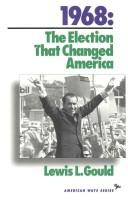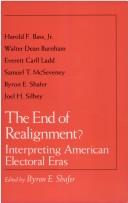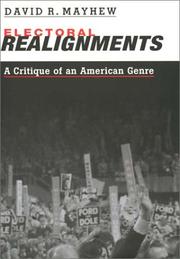| Listing 1 - 7 of 7 |
Sort by
|

ISBN: 156663010X Year: 1993 Publisher: Chicago Ivan R. Dee
Abstract | Keywords | Export | Availability | Bookmark
 Loading...
Loading...Choose an application
- Reference Manager
- EndNote
- RefWorks (Direct export to RefWorks)

ISBN: 0299129748 0299129705 9780299129705 9780299129743 Year: 1991 Publisher: Madison University of Wisconsin Press
Abstract | Keywords | Export | Availability | Bookmark
 Loading...
Loading...Choose an application
- Reference Manager
- EndNote
- RefWorks (Direct export to RefWorks)

ISBN: 1281722294 9786611722296 0300130031 9780300130034 9780300093360 0300093365 9781281722294 6611722297 Year: 2002 Publisher: New Haven, CT Yale University Press
Abstract | Keywords | Export | Availability | Bookmark
 Loading...
Loading...Choose an application
- Reference Manager
- EndNote
- RefWorks (Direct export to RefWorks)
The study of electoral realignments is one of the most influential and intellectually stimulating enterprises undertaken by American political scientists. Realignment theory has been seen as a science able to predict changes, and generations of students, journalists, pundits, and political scientists have been trained to be on the lookout for "signs" of new electoral realignments. Now a major political scientist argues that the essential claims of realignment theory are wrong-that American elections, parties, and policymaking are not (and never were) reconfigured according to the realignment calendar. David Mayhew examines fifteen key empirical claims of realignment theory in detail and shows us why each in turn does not hold up under scrutiny. It is time, he insists, to open the field to new ideas. We might, for example, adopt a more nominalistic, skeptical way of thinking about American elections that highlights contingency, short-term election strategies, and valence issues. Or we might examine such broad topics as bellicosity in early American history, or racial questions in much of our electoral history. But we must move on from an old orthodoxy and failed model of illumination.
Book

ISBN: 0691075905 1322885397 0691606625 140087114X 0691100624 0691635331 9781400871148 9780691606620 9780691100623 9780691075907 Year: 2015 Publisher: Princeton, NJ
Abstract | Keywords | Export | Availability | Bookmark
 Loading...
Loading...Choose an application
- Reference Manager
- EndNote
- RefWorks (Direct export to RefWorks)
Concentrating on the American historical experience, the contributors to this volume apply quantitative techniques to the study of popular voting behavior. Their essays address problems of improving conceptualization and classifications of voting patterns, accounting for electoral outcomes, examining the nature and impact of constraints on participation, and considering the relationship of electoral behavior to subsequent public policy.The writers draw upon various kind of data: time series of election returns, census enumerations that provide the social and economic characteristics of voting populations, and individual poll books and other lists that indicate whom the individual voters actually supported. Appropriate statistical techniques serve to order the data and aid in evaluating relationships among them. The contributions cover electoral behavior throughout most of American history, as reflected by collections in official and private archives.Originally published in 1978.The Princeton Legacy Library uses the latest print-on-demand technology to again make available previously out-of-print books from the distinguished backlist of Princeton University Press. These editions preserve the original texts of these important books while presenting them in durable paperback and hardcover editions. The goal of the Princeton Legacy Library is to vastly increase access to the rich scholarly heritage found in the thousands of books published by Princeton University Press since its founding in 1905.
Elections --- History. --- #SBIB:328H31 --- 328 <73> --- 328 <73> Parlement. Volksvertegenwoordiging. Regering en parlement--Verenigde Staten van Amerika. VSA. USA --- Parlement. Volksvertegenwoordiging. Regering en parlement--Verenigde Staten van Amerika. VSA. USA --- History --- Instellingen en beleid: VSA / USA --- Elections - United States - History
Book
ISBN: 0871875136 9780871875136 Year: 1990 Publisher: Washington Congressional quarterly
Abstract | Keywords | Export | Availability | Bookmark
 Loading...
Loading...Choose an application
- Reference Manager
- EndNote
- RefWorks (Direct export to RefWorks)
Elections --- Political parties --- History. --- -Political parties --- -#KVHA:Politiek; Verenigde Staten --- #KVHA:American Studies --- Parties, Political --- Party systems, Political --- Political party systems --- Political science --- Divided government --- Intra-party disagreements (Political parties) --- Political conventions --- Electoral politics --- Franchise --- Polls --- Politics, Practical --- Plebiscite --- Political campaigns --- Representative government and representation --- History --- #KVHA:Politiek; Verenigde Staten --- Elections - United States - History. --- Political parties - United States - History.
Book
ISBN: 9781139333733 9781107029484 9781107616752 9781139776981 1139776983 1283741482 9781283741484 1139333739 1107029481 1107616751 1139794388 1316090302 110725485X 1139780026 1139783017 Year: 2012 Publisher: New York Cambridge University Press
Abstract | Keywords | Export | Availability | Bookmark
 Loading...
Loading...Choose an application
- Reference Manager
- EndNote
- RefWorks (Direct export to RefWorks)
This study proposes and assesses an alternative explanation of the changes in the relationship between presidential and House of Representatives election results during the last century. Jeffrey M. Stonecash argues that the separation of presidential and House election results that occurred from the 1960s to 1980 was a party-driven process, with both parties seeking to change their electoral base. Republicans sought a more conservative electoral base to counter what they saw as disturbing liberal trends in the nation. Democrats sought to reduce their reliance on the South and its conservativism. Presidential and House election results changed at different rates, creating an appearance that they were unconnected, but they eventually came together. Although many saw these changes in election results as evidence of parties' decline, this study reaffirms their position as central actors in bringing about change.
Elections -- United States -- History. --- Political parties -- United States. --- Presidents -- United States -- Election. --- United States. Congress -- Elections. --- Elections --- Presidents --- Political parties --- Government - U.S. --- Law, Politics & Government --- Political Rights - U.S. --- History --- Election --- Social Sciences --- Political Science --- History. --- Election. --- United States. --- Elections.
Book
ISBN: 0773411593 9780773411593 Year: 2011 Publisher: Lewiston Edwin Mellen Press
Abstract | Keywords | Export | Availability | Bookmark
 Loading...
Loading...Choose an application
- Reference Manager
- EndNote
- RefWorks (Direct export to RefWorks)
This work is a historical analysis and examination of the reasons that cause politicians switch parties and how parties handle or punish apostasy.
Elections -- United States -- History -- Encyclopedias. --- Party affiliation -- United States -- History -- Encyclopedias. --- Politicians -- United States -- Biography -- Encyclopedias. --- United States -- Politics and government -- Encyclopedias. --- Party affiliation --- Politicians --- Elections --- Government - U.S. --- Law, Politics & Government --- Political Rights - U.S. --- Electoral politics --- Franchise --- Polls --- Political science --- Politics, Practical --- Plebiscite --- Political campaigns --- Representative government and representation --- Statesmen --- Affiliation, Party --- Political affiliation --- Political parties --- History --- Membership --- United States --- Politics and government --- ABŞ --- ABSh --- Ameerika Ühendriigid --- America (Republic) --- Amerika Birlăshmish Shtatlary --- Amerika Birlăşmi Ştatları --- Amerika Birlăşmiş Ştatları --- Amerika ka Kelenyalen Jamanaw --- Amerika Qūrama Shtattary --- Amerika Qŭshma Shtatlari --- Amerika Qushma Shtattary --- Amerika (Republic) --- Amerikai Egyesült Államok --- Amerikanʹ Veĭtʹsėndi︠a︡vks Shtattnė --- Amerikări Pĕrleshu̇llĕ Shtatsem --- Amerikas Forenede Stater --- Amerikayi Miatsʻyal Nahangner --- Ameriketako Estatu Batuak --- Amirika Carékat --- AQSh --- Ar. ha-B. --- Arhab --- Artsot ha-Berit --- Artzois Ha'bris --- Bí-kok --- Ē.P.A. --- EE.UU. --- Egyesült Államok --- ĒPA --- Estados Unidos --- Estados Unidos da América do Norte --- Estados Unidos de América --- Estaos Xuníos --- Estaos Xuníos d'América --- Estatos Unitos --- Estatos Unitos d'America --- Estats Units d'Amèrica --- Ètats-Unis d'Amèrica --- États-Unis d'Amérique --- Fareyniḳṭe Shṭaṭn --- Feriene Steaten --- Feriene Steaten fan Amearika --- Forente stater --- FS --- Hēnomenai Politeiai Amerikēs --- Hēnōmenes Politeies tēs Amerikēs --- Hiwsisayin Amerikayi Miatsʻeal Tērutʻiwnkʻ --- Istadus Unidus --- Jungtinės Amerikos valstybės --- Mei guo --- Mei-kuo --- Meiguo --- Mî-koet --- Miatsʻyal Nahangner --- Miguk --- Na Stàitean Aonaichte --- NSA --- S.U.A. --- SAD --- Saharat ʻAmērikā --- SASht --- Severo-Amerikanskie Shtaty --- Severo-Amerikanskie Soedinennye Shtaty --- Si︠e︡vero-Amerikanskīe Soedinennye Shtaty --- Sjedinjene Američke Države --- Soedinennye Shtaty Ameriki --- Soedinennye Shtaty Severnoĭ Ameriki --- Soedinennye Shtaty Si︠e︡vernoĭ Ameriki --- Spojené obce severoamerické --- Spojené staty americké --- SShA --- Stadoù-Unanet Amerika --- Stáit Aontaithe Mheiriceá --- Stany Zjednoczone --- Stati Uniti --- Stati Uniti d'America --- Stâts Unîts --- Stâts Unîts di Americhe --- Steatyn Unnaneysit --- Steatyn Unnaneysit America --- SUA (Stati Uniti d'America) --- Sŭedineni amerikanski shtati --- Sŭedinenite shtati --- Tetã peteĩ reko Amérikagua --- U.S. --- U.S.A. --- United States of America --- Unol Daleithiau --- Unol Daleithiau America --- Unuiĝintaj Ŝtatoj de Ameriko --- US --- USA --- Usono --- Vaeinigte Staatn --- Vaeinigte Staatn vo Amerika --- Vereinigte Staaten --- Vereinigte Staaten von Amerika --- Verenigde State van Amerika --- Verenigde Staten --- VS --- VSA --- Wááshindoon Bikéyah Ałhidadiidzooígíí --- Wilāyāt al-Muttaḥidah --- Wilāyāt al-Muttaḥidah al-Amirīkīyah --- Wilāyāt al-Muttaḥidah al-Amrīkīyah --- Yhdysvallat --- Yunaeted Stet --- Yunaeted Stet blong Amerika --- ZDA --- Združene države Amerike --- Zʹi︠e︡dnani Derz︠h︡avy Ameryky --- Zjadnośone staty Ameriki --- Zluchanyi︠a︡ Shtaty Ameryki --- Zlucheni Derz︠h︡avy --- ZSA --- Η.Π.Α. --- Ηνωμένες Πολιτείες της Αμερικής --- Америка (Republic) --- Американь Вейтьсэндявкс Штаттнэ --- Америкӑри Пӗрлешӳллӗ Штатсем --- САЩ --- Съединените щати --- Злучаныя Штаты Амерыкі --- ولايات المتحدة --- ولايات المتّحدة الأمريكيّة --- ولايات المتحدة الامريكية --- 미국 --- États-Unis --- É.-U. --- ÉU
| Listing 1 - 7 of 7 |
Sort by
|

 Search
Search Feedback
Feedback About UniCat
About UniCat  Help
Help News
News